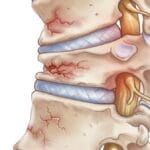A persistent burning sensation on the outer thigh may indicate that a major sensory nerve in the leg—the lateral femoral cutaneous nerve (LFCN)—is under pressure. This condition, medically termed meralgia paresthetica, occurs when the LFCN becomes compressed, leading to discomfort and potential nerve dysfunction.
Nerves play a crucial role by:
- Transmitting sensory information from the environment to the brain
- Sending motor signals from the brain to muscles, enabling movement
For nerves to function effectively, they must navigate around joints, bones, and muscles. Generally, there is ample space to allow this passage without restriction.
In cases of meralgia paresthetica, however, factors like swelling, physical trauma, or added pressure can limit this space, compressing the nerve. This compression can lead to symptoms such as pain, numbness, and other sensory or motor issues.
Symptoms of Meralgia Paresthetica
Meralgia paresthetica typically presents on one side of the body and may include:
- Pain along the outer thigh, occasionally radiating to the knee
- A burning, tingling, or numb sensation in the affected area
- Sometimes, a dull ache in the groin or discomfort extending to the buttocks
- Increased sensitivity to light touch over firm pressure on the affected skin
Medical Evaluation for Diagnosis
During your consultation, the doctor will inquire about any recent surgeries, hip injuries, or repetitive movements that could contribute to nerve irritation.
If meralgia paresthetica is suspected, your doctor will focus on identifying potential factors that might be compressing the nerve.
Common causes include restrictive clothing or weight gain. Your doctor may ask if you frequently wear tight stockings, leggings, body shapers, or a heavy tool belt for work. Additionally, a seatbelt injury during a vehicle accident can also lead to this nerve compression.
Physical Examination for Meralgia Paresthetica
During a physical exam, your doctor will assess sensory differences between your legs to determine any abnormalities. To identify the exact site of the burning pain, they may apply pressure to the nerve, attempting to replicate the sensation you’re experiencing. Additionally, abdominal or pelvic exams may be necessary to rule out other potential issues in those areas.
Diagnostic Tests
Several tests may be used to identify the cause of nerve compression:
- X-rays: Useful for detecting any bone irregularities that might compress the nerve.
- MRI or CT scan: If a growth, such as a tumor, is suspected, imaging tests like MRI or CT scans may be ordered.
- Nerve Conduction Study: Rarely, this test is used to assess nerve function.
- Diagnostic Injection: In some cases, an injection with a numbing agent like lidocaine may be administered to confirm the diagnosis.
Treatment Options for Meralgia Paresthetica
Treatment approaches depend on the underlying cause of the nerve compression. The primary goal is to alleviate pressure on the nerve. Potential treatments include:
- Resting from activities that trigger symptoms
- Weight loss, if weight gain is a contributing factor
- Wearing loose-fitting clothing
- Using a toolbox instead of a tool belt for work tasks
Recovery may take time, and while pain relief is often achievable, some numbness may persist. For more persistent symptoms, corticosteroid injections may be administered to reduce inflammation, providing temporary relief. In rare, severe cases, surgery may be necessary to relieve pressure on the nerve.





